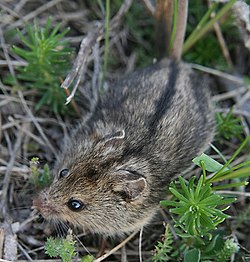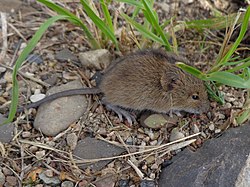| Common name | Scientific name and subspecies | Range | Size and ecology | IUCN status and estimated population |
|---|
| Altai birch mouse
| S. napaea
Hollister, 1912 | Eastern Kazakhstan and southern Russia | Size: 6–8 cm (2–3 in) long, plus 8–11 cm (3–4 in) tail [4]
Habitat: Shrubland and grassland [5] | LC
Unknown  [5] [5]
|
|---|
| Armenian birch mouse
| S. armenica
Baskevich, 1988 | Armenia | Size: About 7 cm (3 in) long, plus 9–11 cm (4 in) tail [6]
Habitat: Grassland [7] | CR
Unknown  [7] [7]
|
|---|
| Caucasian birch mouse
| S. caucasica
Vinogradov, 1925 | Southwestern Russia and northern Georgia | Size: 4–7 cm (2–3 in) long, plus 8–11 cm (3–4 in) tail [6]
Habitat: Grassland [8] | NT
Unknown  [8] [8]
|
|---|
| Chinese birch mouse  | S. concolor
(Büchner, 1892) | Central and western China | Size: 5–8 cm (2–3 in) long, plus 8–11 cm (3–4 in) tail [6]
Habitat: Forest, shrubland, and grassland [9] | LC
Unknown  [9] [9]
|
|---|
| Gray birch mouse
| S. pseudonapaea
Strautman, 1949 | Eastern Kazakhstan and northwestern China | Size: 6–8 cm (2–3 in) long, plus 8–11 cm (3–4 in) tail [4]
Habitat: Forest, shrubland, and grassland [10] | LC
Unknown  [10] [10]
|
|---|
| Hungarian birch mouse  | S. trizona
(Frivaldszky, 1865) | Hungary and Romania | Size: 5–7 cm (2–3 in) long, plus 6–10 cm (2–4 in) tail [4]
Habitat: Grassland [11] | EN
Unknown  [11] [11]
|
|---|
| Kazbeg birch mouse
| S. kazbegica
Sokolov, Baskevich, & Kovalskaya, 1986 | Georgia and southwestern Russia | Size: 6–7 cm (2–3 in) long, plus 9–11 cm (4 in) tail [6]
Habitat: Grassland [12] | VU
Unknown  [12] [12]
|
|---|
| Kluchor birch mouse
| S. kluchorica
Sokolov, Kovalskaya, & Baskevich, 1980 | Georgia and southwestern Russia | Size: 6–8 cm (2–3 in) long, plus 8–11 cm (3–4 in) tail [6]
Habitat: Grassland [13] | LC
Unknown  [13] [13]
|
|---|
| Long-tailed birch mouse
| S. caudata
Thomas, 1907 | Eastern Russia and eastern China | Size: 6–8 cm (2–3 in) long, plus 9–12 cm (4–5 in) tail [6]
Habitat: Forest and grassland [14] | LC
Unknown  [14] [14]
|
|---|
| Nordmann's birch mouse
| S. loriger
(Nathusius, 1840) | Eastern Europe and southwestern Russia | Size: 5–8 cm (2–3 in) long, plus 6–9 cm (2–4 in) tail [4]
Habitat: Grassland [15] | CR
Unknown  [15] [15]
|
|---|
| Northern birch mouse  | S. betulina
(Pallas, 1779) | Central, eastern, and northern Europe and western Asia
 | Size: 5–8 cm (2–3 in) long, plus 8–10 cm (3–4 in) tail [4]
Habitat: Forest, grassland, and inland wetlands [16] | LC
Unknown  [16] [16]
|
|---|
| Severtzov's birch mouse
| S. severtzovi
Ogniov, 1935 | Southwestern Russia
 | Size: 6–8 cm (2–3 in) long, plus 7–9 cm (3–4 in) tail [4]
Habitat: Grassland [17] | CR
Unknown  [17] [17]
|
|---|
| Southern birch mouse  | S. subtilis
(Pallas, 1773) | Central Asia | Size: 5–8 cm (2–3 in) long, plus 7–9 cm (3–4 in) tail [4]
Habitat: Shrubland and grassland [18] | LC
Unknown  [18] [18]
|
|---|
| Strand's birch mouse
| S. strandi
(Formozov, 1931) | Ukraine and southwestern Russia | Size: 6–8 cm (2–3 in) long, plus 8–11 cm (3–4 in) tail [4]
Habitat: Forest and grassland [19] | LC
Unknown  [19] [19]
|
|---|
| Tien Shan birch mouse
| S. tianshanica
(Zalensky, 1903) | Central Asia | Size: 5–8 cm (2–3 in) long, plus 10–12 cm (4–5 in) tail [6]
Habitat: Forest and grassland [20] | LC
Unknown  [20] [20]
|
|---|
| Tsimlyansk birch mouse
| S. cimlanica
Kovalskaya, Tikhonov, Tikhonova, Surov, & Bogomolov, 2000 | Ukraine and southwestern Russia | Size: Unknown [4]
Habitat: Grassland [21] | NT
Unknown  [21] [21]
|
|---|






